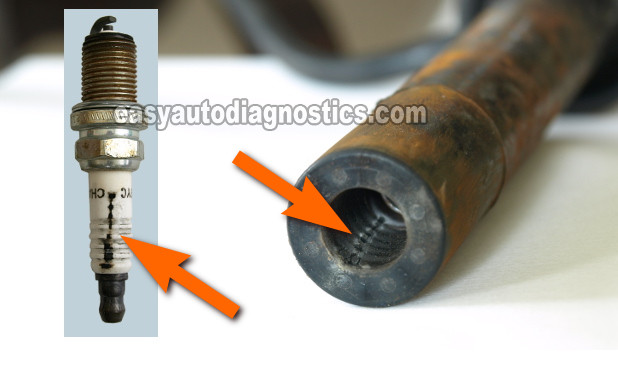TEST 5: Triggering Signal Oscilloscope Test

If you have an oscilloscope, then this test section will help you set it up to test for the ignition coil's triggering signal.
Let's get started:
- 1
Set the oscilloscope to Volts DC mode.
- 2
Probe the circuit labeled with the number 3 (see photo above) with the red oscilloscope test lead (using an appropriate tool to pierce the wire or to back probe the connector).
- 3
Connect the black oscilloscope test lead to the battery negative (-) terminal.
- 4
Have your helper crank the engine. Careful, the engine may start!
- 5
If the Triggering signal is present the oscilloscope should display the wave form in the photo above.
Let's see what your oscilloscope test result means:
CASE 1: The wave form is present. Then the Triggering signal is present. This result indicates, beyond a shadow of a doubt, that the Coil-On-Plug ignition coil on your Nissan Altima or Sentra is bad and needs to be replaced. Replacing the ignition coil will solve the misfire code (P0301, P0302, P0303, P0304) that's lighting up the malfunction indicator lamp (MIL) on your instrument cluster.
CASE 2: The wave form is not present. Re-check all of your connections and repeat the test again. If still no spark, then this results eliminates the ignition coil as the source of the no-spark condition/misfire, since without the Triggering signal the COP ignition coil will not work.
The most likely cause of this missing signal is an open-circuit problem in the signal wire between the coil's connector and the fuel injection computer.
TEST 6: Carbon Tracks And Other Stuff

You've reached this test step because there's a good possibility that the misfire, that your Nissan Altima or Sentra is experiencing, isn't due to a bad Coil-On-Plug ignition coil. This section will delve into other possible causes.
One of them is carbon tracks. Carbon tracks are one of the leading causes of misfires. This condition usually occurs on vehicles that have over 100,000 miles on them and is a result of lack of maintenance (since the spark plugs should have been replaced at this mileage or before). Of course the spark plugs should perform flawlessly for one hundred thousand miles (100,000) theoretically speaking (I never learned to speak Theoretical). But this doesn't really happen in real life.
So, to make the long story short (you're probably already getting eye-strain from reading this article), you should check for carbon tracks on the ignition coil boots and the spark plugs. In the photo above, you'll see what they look like. Below are other suggestions to look into:
- Low engine cylinder compression in one or more cylinders.
- Bad fuel injectors.
- Leaking intake manifold gasket.
- Fuel pressure regulator gone bad and leaking fuel into its vacuum hose.

If this info saved the day, buy me a beer!


